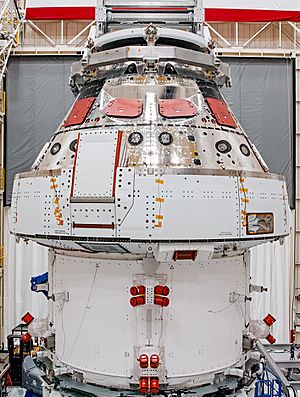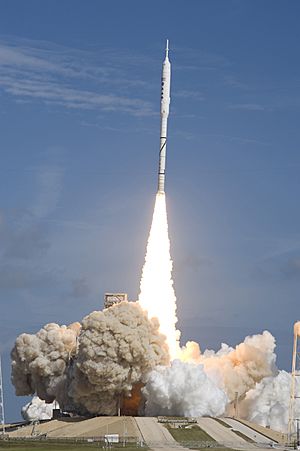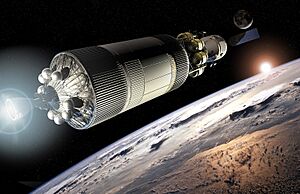Constellation program facts for kids
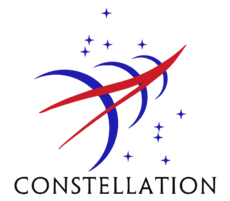 |
|
| Country | United States |
|---|---|
| Organization | NASA |
| Purpose |
|
| Status | Cancelled |
| Program history | |
| Cost | $230 billion (2004) |
| Duration | 2004–2010 |
| First flight |
|
| Last flight |
|
| Successes | 2 |
| Launch site(s) |
|
| Vehicle information | |
| Crewed vehicle(s) |
|
| Launch vehicle(s) | |
The Constellation program (also called CxP) was a crewed spaceflight program. It was created by NASA, the United States' space agency, and ran from 2005 to 2010.
The main goals of the program were:
- To finish building the International Space Station (ISS).
- To send astronauts back to the Moon by 2020.
- To eventually send a crewed mission to Mars.
The program's logo showed these three goals: Earth (for the ISS), the Moon, and Mars. The rockets used in the program were named Ares, which is the Greek name for the Roman god Mars. This name also pointed to the goal of reaching Mars.
Constellation aimed to help astronauts gain more experience traveling beyond low Earth orbit. It also worked on new technologies needed for humans to live on other planets for longer periods.
The Constellation program started because of a plan called the Vision for Space Exploration. This plan was set by President George W. Bush. Later, a study called the Exploration Systems Architecture Study changed how NASA would try to reach these goals. The NASA Authorization Act of 2005 made these changes official. This law told NASA to "develop a sustained human presence on the Moon." This was meant to be a step towards exploring Mars and other places.
However, in 2009, a group called the Augustine Committee found that the Constellation program needed a lot more money to work. Because of this, President Barack Obama suggested canceling the program in 2010. The NASA Authorization Act of 2010 officially ended the program. In 2011, NASA began working on a new rocket system called the Space Launch System.
Spacecraft and Rockets
One of the main goals of Constellation was to create new spacecraft and rockets. These new designs would replace the Space Shuttle. NASA started designing two main rockets, the Ares I and Ares V, when the program began.
- The Ares I was designed to launch only the crew into orbit.
- The Ares V was planned to carry heavier equipment into space.
Besides these rockets, NASA also designed other spacecraft for Constellation. These included the Orion crew capsule, the Earth Departure Stage (a second-stage booster), and the Altair lunar lander.
Orion Spacecraft
The Orion spacecraft was designed to carry astronauts. It was meant to be used for missions in low Earth orbit and later for deep-space travel. Lockheed Martin was chosen to build Orion in 2006.
Orion has three main parts:
- A crew module (CM) that looks like the Apollo command module. It can hold four to six astronauts.
- A service module (SM) that holds the main engines and supplies.
- A Launch Abort System (LAS) that can pull the crew module away from the rocket if there's a problem during launch.
The Orion Crew Module was designed to be reusable. This would allow NASA to use the same capsules for many flights.
Even though the Constellation program was canceled, work on the Orion spacecraft continued. It had a test launch in December 2014. Orion flew on the Artemis I mission in 2022. It is also planned to fly on Artemis II in 2026 and other future missions.
Altair Lunar Lander
Altair was designed to be the main vehicle for astronauts landing on the Moon. It was much larger than the Apollo Lunar Module used in the Apollo program. Altair was almost five times bigger inside. It was planned to be about 32 feet (9.8 meters) tall and 49 feet (15 meters) wide.
Like the Apollo Lunar Module, Altair had two parts:
- An ascent stage, where the four-person crew would live.
- A descent stage, which held the landing gear, supplies like oxygen and water, and scientific equipment.
Altair was designed to land in the Moon's polar regions. NASA was interested in these areas for building future lunar bases. The ascent stage of Altair would be left behind on the Moon after use, just like the Apollo Lunar Module.
Ares Rockets
NASA planned to use two different rockets for the Constellation Program:
This plan allowed each rocket to be built for its specific job. It also meant the Ares V could lift much heavier loads without being too expensive. The name Ares was chosen because it refers to Mars, the program's ultimate goal. The numbers I and V were chosen to honor the Saturn rockets from the 1960s.
Ares I Rocket
The Ares I rocket, sometimes called the "Stick," was meant to launch the Orion spacecraft into low Earth orbit. It was made by several companies, including Alliant Techsystems and Boeing.
The Ares I had a large Solid Rocket Booster (SRB) similar to those used on the Space Shuttle. On top of this was a second stage powered by a liquid-fueled J-2X rocket engine. NASA chose the Ares designs because they were expected to be safe, reliable, and cost-effective.
NASA tested the Ares I first stage on October 28, 2009, with the Ares I-X flight. They also tested the Orion launch abort system before the program was canceled.
Ares V Rocket
The Ares V rocket was designed to be very powerful. It could lift about 188 metric tons (414,000 pounds) to low Earth orbit. This was much more than the Space Shuttle (24.4 metric tons) and even more than the Saturn V (118 metric tons). For missions to the Moon, Ares V could carry about 71 metric tons (156,000 pounds).
The Ares V design included six RS-68 engines and two large solid rocket boosters. These RS-68 engines were more powerful and simpler than other options, making them less expensive. The Ares V would have launched the Earth Departure Stage and the Altair spacecraft into low Earth orbit. They would then wait for the Orion spacecraft to arrive.
Earth Departure Stage
The Earth Departure Stage (EDS) was a propulsion system. It was designed to push the Altair spacecraft from low Earth orbit towards the Moon. It was the second liquid-fueled stage of the Ares V rocket.
The Orion spacecraft would launch separately on an Ares I rocket. It would then meet and dock with the Ares V-launched EDS/Altair combination. This process, called Earth orbit rendezvous, would prepare the spacecraft for its journey to the Moon.
Mission Plans
The Constellation program planned missions similar to the Apollo Program. These included flights to the International Space Station and crewed missions to the Moon's polar regions. There were also early plans for a mission to a near-Earth asteroid. While a crewed flight to Mars was the ultimate goal, detailed plans for it were not fully developed before the program ended.
ISS and Low-Earth Orbit Flights
For missions to the International Space Station, the Ares I rocket and Orion spacecraft would be put together at the Kennedy Space Center. Once ready, a large crawler-transporter would move the rocket and spacecraft to the launchpad.
After final checks, the rocket's second stage would be filled with fuel. The crew, wearing special spacesuits, would enter the Orion spacecraft a few hours before launch. Once everything was clear, the Ares I would launch.
After about two days, the Orion spacecraft would meet and dock with the International Space Station. The crew, up to six people, would then enter the station. They would perform tasks for about six months. When their mission was done, they would return to the Orion, undock from the ISS, and head back to Earth.
The Orion's Command Module would re-enter Earth's atmosphere. It would use a heat shield to slow down from about 17,500 miles per hour (28,000 km/h) to 300 miles per hour (480 km/h). After re-entry, parachutes and airbags would deploy. The spacecraft would then splash down in the ocean. Unlike the Apollo capsules, which were used once, an Orion Command Module could be used up to ten times.
Lunar Missions
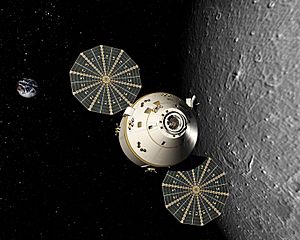
Unlike the Apollo missions, where the crew and lunar lander launched together, Constellation planned to launch them separately.
- First, the uncrewed Ares V rocket would launch the EDS and the Altair lunar lander into orbit.
- About 90 minutes later, the Ares I rocket would launch the crewed Orion spacecraft into a similar orbit.
The Orion spacecraft would then meet and dock with the Altair/EDS combination in low-Earth orbit. After preparing for lunar flight, the EDS would fire its engines. This would speed up the spacecraft to about 25,000 miles per hour (40,200 km/h) to send it towards the Moon. After this burn, the EDS would be released.
During the three-day trip to the Moon, the four-person crew would check their systems. As they approached the Moon, the Orion/Altair combination would slow down to enter lunar orbit.
Once in lunar orbit, the crew would prepare the Orion for uncrewed flight. All four astronauts would then move into the Altair vehicle to land on the Moon. The Orion would wait in orbit for their return. After getting approval from Mission Control, the Altair would undock from Orion and begin its descent to a chosen landing site.
On the Moon, the crew would put on their extravehicular activity (EVA) spacesuits. They would then perform several moonwalks, collecting samples and setting up experiments. After their work, the crew would re-enter the Altair. They would then fire the ascent stage engine to lift off from the Moon's surface, leaving the descent stage behind.
Once in lunar orbit, the Altair would meet and dock with the waiting Orion spacecraft. The crew would transfer back to Orion, bringing their Moon samples. After releasing the Altair, the crew would fire Orion's engines to begin the trip back to Earth.
After about two and a half days, the crew would release the Service Module. The Orion capsule would then re-enter Earth's atmosphere. It would slow down from 25,000 miles per hour (40,200 km/h) to 300 miles per hour (480 km/h) and splash down in the Pacific Ocean. The capsule would then be taken back to Kennedy Space Center for future use.
Orion Asteroid Mission
The Orion Asteroid Mission was a proposed NASA mission to a near-Earth asteroid. It would have used the standard Orion spacecraft and a modified Altair lunar lander. This mission aimed to study asteroids for resources like water and metals. It also would have tested ways to protect Earth from asteroid impacts. This would have been the first crewed mission to an extraterrestrial body other than the Moon. It was seen as a step towards a human mission to Mars.
The mission would have started like the lunar landing mission. An Ares V would launch the landing module into Low Earth orbit. Then, an Ares I would launch the Orion spacecraft with a two or three-person crew. Once Orion docked with the landing module and the Earth Departure Stage (EDS), the EDS would propel the Orion spacecraft to a nearby asteroid. The crew would then land and explore its surface.
After completing their tasks, the Orion spacecraft would leave the asteroid. Near Earth, it would release the service module and landing module. The Orion capsule would then re-enter the atmosphere for a Pacific Ocean splashdown.
Orion Mars Mission
The biggest goal of NASA's Constellation program was to land humans on Mars in the 2030s. This mission would have used Constellation hardware, mainly the Orion spacecraft and the Ares V cargo rocket.
A study called Design Reference Architecture 5.0 was completed in 2009. It showed how a Mars mission could work using Constellation rockets. It would involve multiple launches of Ares V rockets and an Ares I to launch the crew. Cargo, including a Mars Ascent Vehicle (MAV) and equipment to make fuel on Mars, would be sent first. A habitat for the astronauts would also be sent.
Later, the crew would travel to Mars in a special vehicle. Once at Mars, the crew would meet the habitat in orbit, land on Mars, and explore for 500 days. They would use the MAV to return to their vehicle in Mars orbit, which would then bring them back to Earth. The mission would end with the Orion capsule returning to Earth.
Why Return to the Moon?
NASA listed several reasons for humans to return to the Moon:
- To expand human colonization.
- To do more scientific research on the Moon.
- To test new technologies and ways of flying for future space exploration.
- To create a challenging and peaceful activity that brings nations together.
- To expand economic opportunities and conduct research that helps Earth.
- To inspire the public and students, helping to develop a skilled workforce for the future.
Former NASA Administrator, Michael D. Griffin, said that the goal was not just science. It was also about extending where humans can live beyond Earth. He believed that for humans to survive for a very long time, we must eventually live on other planets and explore the Solar System.
A report in 2014 by the US National Academy of Sciences called for clear, long-term space goals for NASA. It suggested that Mars should be the next major goal for human spaceflight. The report also noted that returning to the Moon would be a helpful step towards reaching Mars.
The National Space Society (NSS), a private group, also believes that returning to the Moon is very important. They think it will help us learn more about the Moon and create new industries. This could then help fund more space exploration.
Budget and Cancellation
Bush Administration Plans
On January 14, 2004, President George W. Bush asked NASA to plan for continued crewed space exploration. This plan was to follow the completion of the International Space Station and the planned retirement of the Space Shuttle program in 2010. The goal was to "establish an extended human presence on the Moon." This would help "vastly reduce the costs of further space exploration." It would also include "harvesting and processing of lunar soil into rocket fuel or breathable air." Bush said that this experience would help develop new technologies for "sustainable course of long-term exploration."
NASA estimated that this original plan would cost about $230 billion (in 2004 dollars) through 2025. However, there were still many technical challenges. This made it hard for NASA to give a final cost estimate.
Obama Administration Decisions
When President Obama took office, he stated that Constellation was "over budget, behind schedule, and lacking in innovation." A review found that it would cost around $150 billion for Constellation to meet its goals on the original timeline. Another review in 2009 showed that neither a return to the Moon nor a crewed flight to Mars was possible with NASA's budget at the time. The Augustine panel suggested different options, including focusing on the Moon or deep space.
After reviewing the report, the Obama administration decided not to include funding for Constellation in the 2011 United States federal budget. On February 1, 2010, the President's budget was released without funding for the project. It became law on April 15, 2011.
President Obama held a Space Conference on April 15, 2010. At this conference, he and other leaders discussed the future of U.S. human spaceflight. They revealed a new plan for NASA. This plan continued the development of the Orion capsule. It also set a deadline of 2015 for designing a new Super Heavy Launch Vehicle. In October 2010, the NASA authorization bill for 2010 was signed into law, which officially canceled Constellation.
New Programs: Commercial Crew and Artemis
NASA continues to develop the Orion spacecraft for deep space travel. To save money, NASA has hired private companies to build vehicles for use in low Earth orbit.
- Since May 2020, the Commercial Crew Development program has used the SpaceX Crew Dragon spacecraft to carry astronauts to and from the International Space Station.
- Boeing's Starliner spacecraft also started operating in 2024 for the same purpose.
- Private spacecraft also deliver cargo to the ISS through the Commercial Resupply Services program.
The Orion spacecraft and the Ares V rocket designs were later modified. They were reauthorized in 2010/2011 as the main parts of the Space Launch System. The Constellation program was partly brought back to life as the Artemis program in 2017.
See also
- Artemis program, a similar program by NASA
- Space Launch System
- List of Constellation missions
- Exploration Systems Architecture Study
- NASA's Vision for Space Exploration


